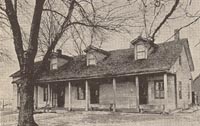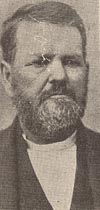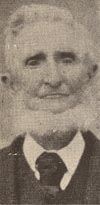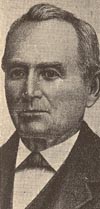|
WILLIAM Warnick, Macon county's first sheriff, appointed to
that office in 1829, was a fine physical specimen of the sturdy
pioneer. That he was recognized as a capable officer, as well,
was shown in the fact that he held the position of sheriff from the
time of the organization of the county in 1829 until 1834, and then
was elected again in 1840 and served two years.
Mr. Warnick was also the first tax collector, but neither the
job nor the salary connected with it was a burden to him. For
collecting the taxes for the year 1829 he was paid $6. No
doubt that was as much as it was worth, for there wasn't much to
collect.
Mr. Warnick was born in 1784 in North Carolina, and later
removed to Rutherford county, Tenn. In the year 1825 he came
to Illinois, settling in Macon county in Blue Mound township.
He lived first in a log cabin across the road from the land he
afterwards bought. In that home Abraham Lincoln was laid up
for a time with frozen feet.
In 1830, Mr. Warnick bought the west half of the northwest
quarter of section 35 from his brother-in-law, Benjamin Wilson,
and in 1833 bought the east half from Robert Peebles.
On the latter ground, he erected the house which afterwards became
know as the Thirty-three mile house. This house, still
standing today, has been known for years as the Hudelson
home.
In 1835, Mr. Warnick entered from the government the forty
acres on which he had first lived, and the forty east of it, but did
not receive his patent until 1838.

WARNICK HOME (THIRTY-THREE MILE HOUSE
(As it appears today)
POPULAR TAVERN
The Thirty-Three mile house was a popular tavern for many years.
It was so named because it was thirty-three miles from Springfield.
The tavern also was called the Eight-mile house, because it was
eight miles from Decatur. It was located on the old Terre
Haute-Springfield road, over which the tide of emigration poured for
years.
The tavern was conducted by John Eckel, into whose hands the
land passed in 1843 at a sheriff's sale, after Warnick had
become financially embarrassed by going security for neighbors.
Eckel made many improvements on the house. No doubt
Lincoln often stopped at this tavern during his travels.
Mr. Warnick was first lieutenant in Captain Johnson's
company of volunteers in the Black Hawk war, and also was captain of
the company of Rangers during that war. He was wounded in the
engagement known as Stillman's defeat. He was always called
Major Warnick, though there is no record to show that he
attained that rank, the title being given him unofficially by
friends, because of his prowess in fighting Indians.
Mr. Warnick was the father of ten children, and many of his
descendants live in Macon county today. He died Feb. 12, 1855.
J. Y. BRADEN
One of the early comers, who became one of the county's most
influential farmers, was J. Y. Braden, whose father, Samuel
Braden, settled here in 1829. J. Y. Braden was
then eleven years old. For nearly twenty years J. Y. Braden
lived in Decatur, then he moved to the farm he had purchased in
Hickory Point township, and lived there the rest of his life.
He bought 80 acres of land in 1848, and added many more to his
holdings later. The Illinois Central railroad passed through
his farm.

J. V. BADEN
Mr. Braden helped organize the township and lay out roads,
and was the first supervisor from Hickory Point township. He
held the office of supervisor for six years. He served in
other public officers, constable, school treasurer, justice of the
peace, member of the county board of agriculture and often was
called upon as manager of county fairs and other projects furthered
by the farmers.
INVEST IN LAND
Macon county, outside Decatur, was adding substantial residents to
its population constantly in the early years of the county.
Farm land was being taken up, and homes were being established.
Some of the farm lands selected then and entered from the government
are part of Decatur today.1
In the spring of 1834 James Geddes and John Sawyer,
cousins, came to Macon county, with money sewed in their belts to
invest in land. Geddes had $1,600 and Sawyer
$2,200. The two had been boys together in Lebanon county, Pa.
They had worked hard, had saved their money and then decided to "go
west." They brought with them Ben Berkshire, the first
negro to come to this county.

JAMES GEDDES
Decatur looked good to the young men. They spent several days
looking around and getting acquainted. They believed the place
had good prospects and they decided to locate. Geddes
entered a tract of 160 acres of land, about where the Wabash
property now is located, and there he built a log cabin. He
constantly added to his land buildings until he had as much as 1,300
acres. Occasionally he would have to sell off a tract to pay
taxes.
Sawyer selected 120 acres, which included what afterwards
became known as "The Pines" on East William street. Then he
went back to Indiana and brought his bride, who had been Eliza
Kettering, here. His first child, Mary, became the wife of
Silas Packard. Mrs. Sawyer died in 1848.
Sawyer often made trips to Chicago, driving an ox team. In
1850 he went to California to hunt gold, and with a part of his
diggings he bought 200 acres on his return. This land he sold
later for $10,000.
Mr. Sawyer, in 1853 married Mrs. Harriet Gulick, widow
of Levi Gulick. For forty years the Sawyers
lived on Sawyer lane, later West Harrison avenue, Decatur. Mr.
Sawyer died in 1893.
Benjamin Sawyer, brother of John Sawyer, native of
Lebanon county, Pa., came to Macon county in 1836. He operated
lumber yards, oil mills and dealt in cattle and land in Illinois and
other states. During the gold rush he went to California.
From 1869 to 1872 he managed trail herds from Texas north to
railroads through Indian Territory. Benjamin Sawyer was
unmarried. He died in Macon county in 1879.
THE SPANGLERS
The Spanglers came to the county in the fall of 1835 from York
county, Pa. Joseph and Barbara Spangler, the parents,
had a family of nine children, eight of whom came to Macon county
with them.
Jacob Spangler was the first of the family to come to
Illinois, making the trip to look over the country. His report
was a favorable one, and the rest of the family then made the
journey west.
The Spanglers entered land east and northeast of Decatur,
having land in three townships. In 1838 they erected the
Spangler mill, well known in the early days.

JACOB SPANGLER
The present day William street bridge formerly was known as the
Spangler bridge.
SELLS AT FOURTEEN DOLLARS AN ACRE
William Foren, who came here in 1830 from Huntsville, Ala.,
owned the farm which later became known as the Johns property, now
the site of the Washington grade school and Johns Hill Junior
high school. Mrs. Foren was dissatisfied here and
wanted to return south, so Mr. Foren sold the land to William
Martin, father of Mrs. Jane M. Johns, at $14 an acre.
Mr. Foren formerly had a meat market about where the
Brunswick hotel now stands. His daughter, Ann Foren,
married Samuel McKinley, who had located here in 1834.
McKinley, who was only 18 years old when he first came here,
was an apprentice of E. O. Smith and Benjamin Dillehunt
and later became a partner of Smith. McKinley
sold his town property in 1845 and bought a farm of 160 acres four
and one-half miles north of Decatur on the Bloomington road.
For that land he paid $25 an acre. Some of his neighbors the
year before had entered government land at $1.25 an acre. The
increase in value of land, which came with the advent of the
railroads, was quickly becoming apparent.
WILLIAMS LAND
Mr. and Mrs. Andrew S. Williams had extensive land holdings
in the north part of Decatur, north of what is now Grand avenue.
They came to Macon county in 1836, Mrs. Williams taught
school in the early days, first in her home and later in a building
erected on the Williams land. Mr. Williams also
at one time owned the land known as College hill.
ROBINSON FAMILY
One early settler, who entered, from the government, land which is
now a part of the city, was Amos Robinson, who came in 1830
from Royalton, Vt.2 He lived only about six years
after coming here, but was active during those early years in the
history of the county. He was one of the men who helped to
build the old log court house. His son, Hartwell, was
identified with the business life of Decatur until his death in
1856.
The Robinsons land was in the west section of the city.
The Springfield road (now West Main street and Route 10) passed
through their land. It was part of this land which later came
into possession of James Milliken, and became the site of his
home and the university.
The Robinsons lived first on the north side of what is now
the 900 block West Main street. After Amos Robinson
located here, he procured 100 apple trees and he and his boys set
them out. Within two or three years the trees were bearing big
crops of apples. Amos Robinson died about 1836, and was
buried in the family burial plot in the midst of the orchard he had
set out a few years before.
Before the elder man's death, father and son had started a chair
factory, located where the Y.M.C.A. annex now stands. In that
shop a horse was used to turn the lathe. For years Hartwell
Robinson made tables, bureaus, chairs, window sash, etc.
About 1850 he started a lumber mill and shop in what is now the 900
block West Main street.3 He also ran a grocery store on the
present site of the Parlor meat market.
Marilla Robinson, daughter of Amos Robinson, married
Dayton Dunham. Amos Dunham, for whom Dunham
Post, G. A. R. was named, was a son of Mr. and Mrs. Dayton Dunham.
About 1845 Hartwell Robinson erected a brick house on the
south side of the road passing his home. He was married that
year to Fairazina Morris, and all their married life they
lived in that home. In 1856 Mr. Robinson sold the place
to Peter Laux, and bit a new residence in the 900 block West
Prairie, but just as the last door was being hung he died. His
widow and children moved to the new home. Both these
Robinson homes stood for many years.
----------------------
1 Land was cheap in
the 30s. J. F. Montgomery, father of the late R. R.
Montgomery, bought a lot in the 100 block South Main street for
a hat. Evidently some one felt a hat was more valuable than
the real estate. Mr. Montgomery bought the east half of
the block on the north side of 100 block East Main street, cornering
on Water, for $35. He first put up a little tailor shop there,
and later erected a better building, two stories high. Then
the Sons of Temperance added a third story to it. When that
building was burned in the fire of 1859 Mr. Montgomery's loss
was $1,000.
Land was cheap until after the railroads came in 1854. The
Packards once sold some land around College square at $2.50 an
acre, and patted themselves on the back for getting such a good
price.
Edmund Packard, when getting ready to go to California to
hunt gold, traded 10 acres now in the midst of Decatur to Rev.
William S. Crissey for a gold watch and chain, and thought he
had the best end of the bargain!
2 The Robinson, the Packard, and the
Hunting families came together to Macon county. A letter
written by Mrs. Robinson to home folks, on Sept. 8, tells of
their safe arrival after a fatiguing journey. They had arrived
July 26. On Sept. 8, the day the letter was written, Mr.
Packard died. Mrs. Robinson deplored the fact that
they were all ill with the chills and ague and unable to attend the
funeral of their friend, Mr. Packard. That was Silas
Packard, Sr., father of the Silas Packard whose name
appears elsewhere in this history. Mrs. Robinson's
letter is given here:
"Decatur, Sept. 8, 1830.
"My dear children, with faint and faltering steps I tread to the
table once more to attempt to write you. We had a long and
fatiguing journey, but not any sickness to detain us one day.
We arrived here July the 26 all in health, but very much fatigued
with our journey, but it has been uncommonly sickly here this season
and we do not escape.
"God has seen fit to lay his afflicting hand upon us and
leaving us all down at a time. Yes, and so very sick for some
days that there was not one able to carry a drink of water to the
other among the five, but thanks be to God our lives are saved,
while others are taken. We are now recovering in health
slowly. We have got able to dress ourselves and walk about the
room very little.
"Now I take your attention to the doleful news. Mr. Packard
is no more. He departed this life this morning at about 1
o'clock, was sick but seven or eight days, and never has been
thought to be dangerous until last evening. He never has
manifested any alarm about himself in his sickness and died in a
bewildered state. Furthermore, I must add that the family are
all sick like, save Mrs. Packard is only able to walk from
one room to the other. I am told she bears her trouble as yet
with great composure.
"Mr. Hunting's family likewise are all sick save the oldest
son. Not one of us will be able to attend the funeral, which
is appointed tomorrow at seven o'clock. This is a solemn time,
indeed, with us, only two miles distant, and we must be deprived of
beholding even the corpse of our ever faithful and worthy friend.
The disorder of which he died, is called fever and ague, together
with the nervous fever. The fever and ague and chill fever
have been our disorder and is very frequent in this vicinity,
especially to new settlers.
"This our friend's death is greatly lamented by all who knew him,
and as for your father, his expectations are apparently all cut off.
He has ever been willing to confide in his judgment at all times,
and finally in a word we were all of us making great dependence on
Mr. Packard's assisting us, but alas, is not this to show
that we must not put our trust in mortal man. Yet I know not
where to leave speaking of him, for this is the theme of our lives.
Our hearts are sad in mourning, and hung on the weeping willows of
grief. Of the bereft widow, her loss cannot be estimated, and
those dear little children deprived of a kind and affectionate
parent at this critical period of life, when so much needed with
them. May the Lord take these little ones in his arms and
bless them and be a father to the fatherless and the widow's god and
guide."
Here is part of a letter written by Hartwell Robinson, then about 18
years old, to his brother back east, Jan. 31, 1833.
"It was a very cold spring and summer. Good corn fit for seed
is so scarce that it is $1 per bushel. We sold our youngest
horse for $60. We sold the harness for $25, took two cows and
one calf, seven hogs, and one day's work. Sold our wagon for
$45, to be paid in braking fifteen acres of prairie and 1500 of
rails. We went to live with the man that bought our youngest
horse. He asked us $25 for getting our wood three months, $12
for wintering our other horse, the cow and calf died. He asked
37 1/2 cents per week for wintering our cow that lived.
"Marm made from the cow sixty weight of cheese and butter so that we
have it plenty through the summer and fall, and have some yet.
Marm had no cheese press so she had to press them by setting them
under the bed post.
"Timber here is mostly oak and walnut, some black walnut and a
little cherry. Father has now sold his tools to pay some of
his debts. There is two saw mills putting up within two miles
of us. Dunham talks of going back to York state.
He has sold some of his things. We received a letter from Amos
last fall. He writ that you was married. Every newcomer
that comes in here very seldom escapes the ague one year. I
believe that I have thought of about everything worth mentioning
except to tell you that we sold the other horse last fall for $80 to
pay the merchants."
3 From a spring on the land they stored enough water in a
well to run this mill. Machinery for this mill, including
engine and boiler, were brought later from Springfield on wagons
drawn by oxen. Dayton Dunham and son, Henry, went to
Springfield to get the machinery. Henry Dunham, it is
believed, is at the time of this writing (1930), the oldest native
born resident of Decatur. He was born in this city April 22,
1838.
<PREVIOUS> <NEXT>
<CLICK
HERE TO RETURN TO TABLE OF CONTENTS>
|